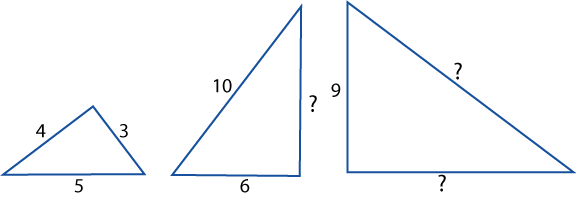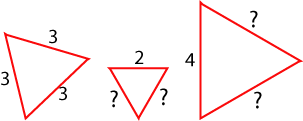Skip over navigation
The triangles in this set are 'similar':

'Similar' means that the triangles are exactly the same shape, but not the same size. The sides are in the same ratio to each other. (Note that these triangles are not drawn to scale.)
What can you say about the length of the side of the third triangle which is marked with a question mark? Of course the triangles could be different ways up, too:

There are five more sets of similar triangles below. Can you work out the lengths of the sides marked with a question mark?
Set 2:

Set 3:

Set 4:

Set 5:

Set 6:


Or search by topic
Number and algebra
Geometry and measure
Probability and statistics
Working mathematically
Advanced mathematics
For younger learners
Number the Sides
Age 7 to 11
Challenge Level 





The triangles in this set are 'similar':

'Similar' means that the triangles are exactly the same shape, but not the same size. The sides are in the same ratio to each other. (Note that these triangles are not drawn to scale.)
What can you say about the length of the side of the third triangle which is marked with a question mark? Of course the triangles could be different ways up, too:

There are five more sets of similar triangles below. Can you work out the lengths of the sides marked with a question mark?
Set 2:

Set 3:

Set 4:

Set 5:

Set 6:

You may also like
Is a Square a Rectangle?
How many rectangles can you find in this shape? Which ones are differently sized and which are 'similar'?

